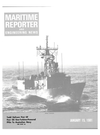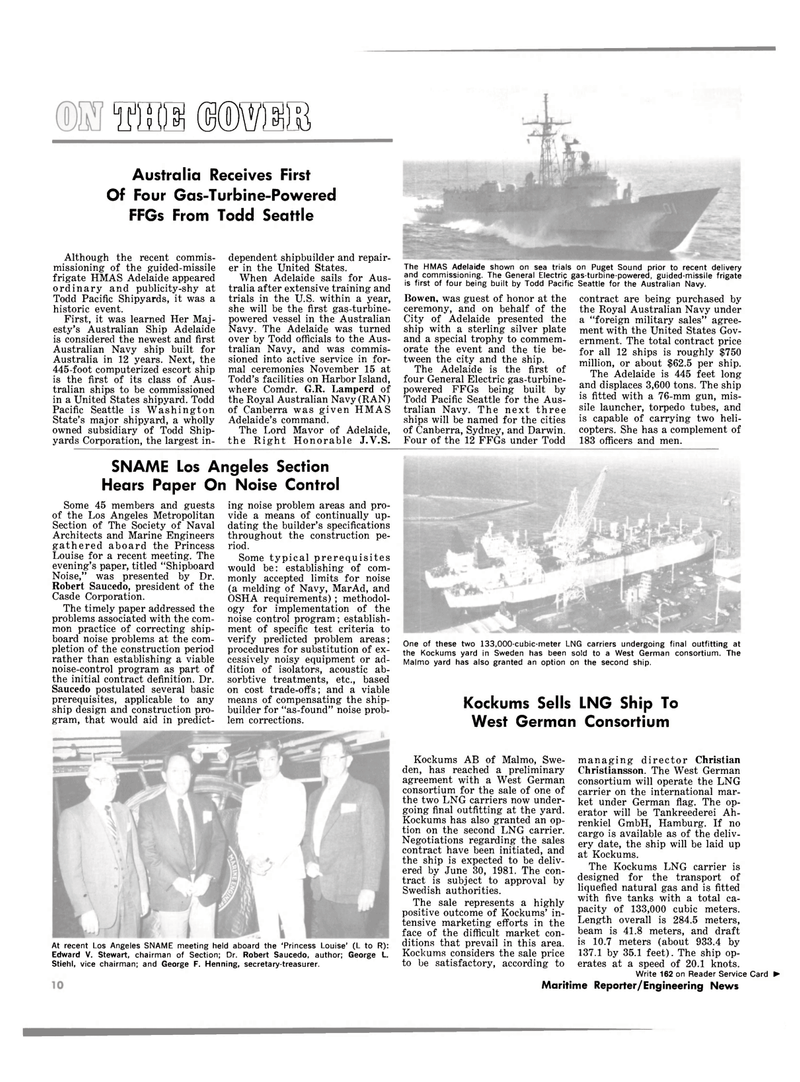
Page 8: of Maritime Reporter Magazine (January 15, 1981)
Read this page in Pdf, Flash or Html5 edition of January 15, 1981 Maritime Reporter Magazine
Australia Receives First
Of Four Gas-Turbine-Powered
FFGs From Todd Seattle fffflfi mmm
The HMAS Adelaide shown on sea trials on Puget Sound prior to recent delivery and commissioning. The General Electric gas-turbine-powered, guided-missile frigate is first of four being built by Todd Pacific Seattle for the Australian Navy.
Although the recent commis- missioning of the guided-missile frigate HMAS Adelaide appeared ordinary and publicity-shy at
Todd Pacific Shipyards, it was a historic event.
First, it was learned Her Maj- esty's Australian Ship Adelaide is considered the newest and first
Australian Navy ship built for
Australia in 12 years. Next, the 445-foot computerized escort ship is the first of its class of Aus- tralian ships to be commissioned in a United States shipyard. Todd
Pacific Seattle is Washington
State's major shipyard, a wholly owned subsidiary of Todd Ship- yards Corporation, the largest in- dependent shipbuilder and repair- er in the United States.
When Adelaide sails for Aus- tralia after extensive training and trials in the U.S. within a year, she will be the first gas-turbine- powered vessel in the Australian
Navy. The Adelaide was turned over by Todd officials to the Aus- tralian Navy, and was commis- sioned into active service in for- mal ceremonies November 15 at
Todd's facilities on Harbor Island, where Comdr. G.R. Lamperd of the Royal Australian Navy (RAN) of Canberra was given HMAS
Adelaide's command.
The Lord Mavor of Adelaide, the Right Honorable J.V.S.
Bowen, was guest of honor at the ceremony, and on behalf of the
City of Adelaide presented the ship with a sterling silver plate and a special trophy to commem- orate the event and the tie be- tween the city and the ship.
The Adelaide is the first of four General Electric gas-turbine- powered FFGs being built by
Todd Pacific Seattle for the Aus- tralian Navy. The next three ships will be named for the cities of Canberra, Sydney, and Darwin.
Four of the 12 FFGs under Todd contract are being purchased by the Royal Australian Navy under a "foreign military sales" agree- ment with the United States Gov- ernment. The total contract price for all 12 ships is roughly $750 million, or about $62.5 per ship.
The Adelaide is 445 feet long and displaces 3,600 tons. The ship is fitted with a 76-mm gun, mis- sile launcher, torpedo tubes, and is capable of carrying two heli- copters. She has a complement of 183 officers and men.
One of these two 133,000-cubic-meter LNG carriers undergoing final outfitting at the Kockums yard in Sweden has been sold to a West German consortium. The
Malmo yard has also granted an option on the second ship.
Kockums Sells LNG Ship To
West German Consortium
Kockums AB of Malmo, Swe- den, has reached a preliminary agreement with a West German consortium for the sale of one of the two LNG carriers now under- going final outfitting at the yard.
Kockums has also granted an op- tion on the second LNG carrier.
Negotiations regarding the sales contract have been initiated, and the ship is expected to be deliv- ered by June 30, 1981. The con- tract is subject to approval by
Swedish authorities.
The sale represents a highly positive outcome of Kockums' in- tensive marketing efforts in the face of the difficult market con- ditions that prevail in this area.
Kockums considers the sale price to be satisfactory, according to managing director Christian
Christiansson. The West German consortium will operate the LNG carrier on the international mar- ket under German flag. The op- erator will be Tankreederei Ah- renkiel GmbH, Hamburg. If no cargo is available as of the deliv- ery date, the ship will be laid up at Kockums.
The Kockums LNG carrier is designed for the transport of liquefied natural gas and is fitted with five tanks with a total ca- pacity of 133,000 cubic meters.
Length overall is 284.5 meters, beam is 41.8 meters, and draft is 10.7 meters (about 933.4 by 137.1 by 35.1 feet). The ship op- erates at a speed of 20.1 knots.
Write 162 on Reader Service Card • 10 Maritime Reporter/Engineering News
SNAME Los Angeles Section
Hears Paper On Noise Control
Some 45 members and guests of the Los Angeles Metropolitan
Section of The Society of Naval
Architects and Marine Engineers gathered aboard the Princess
Louise for a recent meeting. The evening's paper, titled "Shipboard
Noise," was presented by Dr.
Robert Saucedo, president of the
Casde Corporation.
The timely paper addressed the problems associated with the com- mon practice of correcting ship- board noise problems at the com- pletion of the construction period rather than establishing a viable noise-control program as part of the initial contract definition. Dr.
Saucedo postulated several basic prerequisites, applicable to any ship design and construction pro- gram, that would aid in predict- ing noise problem areas and pro- vide a means of continually up- dating the builder's specifications throughout the construction pe- riod.
Some typical prerequisites would be: establishing of com- monly accepted limits for noise (a melding of Navy, MarAd, and
OSHA requirements) ; methodol- ogy for implementation of the noise control program; establish- ment of specific test criteria to verify predicted problem areas; procedures for substitution of ex- cessively noisy equipment or ad- dition of isolators, acoustic ab- sorbtive treatments, etc., based on cost trade-offs; and a viable means of compensating the ship- builder for "as-found" noise prob- lem corrections.
At recent Los Angeles SNAME meeting held aboard the 'Princess Louise' (L to R):
Edward V. Stewart, chairman of Section; Dr. Robert Saucedo, author; George L.
Stiehl, vice chairman; and George F. Henning, secretary-treasurer.

 7
7

 9
9
